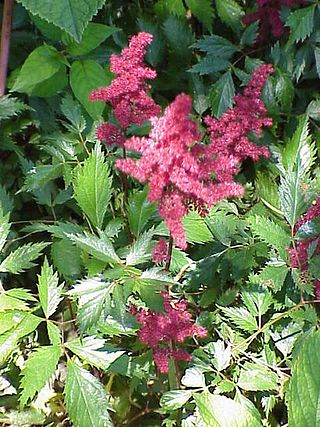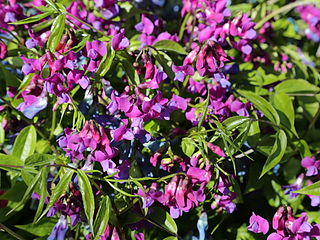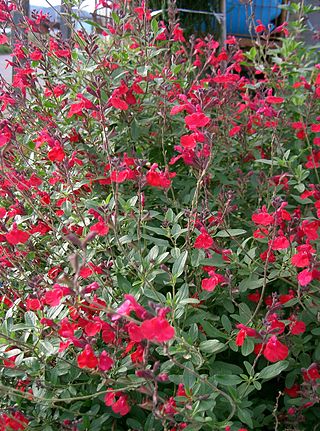
Cytisus is a genus of flowering plants in the family Fabaceae, native to open sites in Europe, western Asia and North Africa. It belongs to the subfamily Faboideae, and is one of several genera in the tribe Genisteae which are commonly called brooms. They are shrubs producing masses of brightly coloured, pea-like flowers, often highly fragrant. Members of the segregate genera Calicotome, Chamaecytisus, and Lembotropis are sometimes included in Cytisus.

Hibiscus syriacus is a species of flowering plant in the mallow family, Malvaceae. It is native to areas of east Asia, but widely introduced elsewhere, including much of Europe and North America. It was given the epithet syriacus because it had been collected from gardens in Syria. Common names include the rose of Sharon,, Syrian ketmia, shrub althea (or simply althea), and rose mallow. It is the national flower of South Korea and is mentioned in the South Korean national anthem.

Rosa gallica, the Gallic rose, French rose, or rose of Provins, is a species of flowering plant in the rose family, native to southern and central Europe eastwards to Turkey and the Caucasus. Rosa gallica was one of the first species of rose to be cultivated in central Europe. It is a parent of several important cultivars.

Erica vagans, the Cornish heath or wandering heath, is a species of flowering plant in the family Ericaceae, native to Ireland, Cornwall, western France and Spain. It is a vigorous, spreading, evergreen heather reaching 75 cm (30 in) tall and wide, with pink flowers borne in racemes 14 cm (6 in) long in summer and autumn. The Latin specific epithet vagans literally means "wandering"; in this context it means "widely distributed".

Erica carnea, the winter heath, winter-flowering heather, spring heath or alpine heath, is a species of flowering plant in the family Ericaceae, native to mountainous areas of central, eastern and southern Europe, where it grows in coniferous woodlands or stony slopes.

Astilbe is a genus of 18 species of rhizomatous flowering plants within the family Saxifragaceae, native to mountain ravines and woodlands in Asia and North America. Some species are known by the common names false goat's beard and false spirea.

Paeonia lactiflora is a species of herbaceous perennial flowering plant in the family Paeoniaceae, native to central and eastern Asia from eastern Tibet across northern China to eastern Siberia.

Anthyllis montana, the mountain kidney vetch, is a species of flowering plant in the family Fabaceae, native to the mountains of Southern Europe and parts of the Alps. Growing to 30 cm (12 in) tall by 60 cm (24 in) broad, it is a clump-forming, woody-based perennial. The leaves are divided into numerous fern-like leaflets and are silky and grey-green in colour. The white, pink or purple clover-like flower-heads are borne in spring and summer. The Latin specific epithet montana refers to mountains or coming from mountains.

Malva trimestris, common names annual mallow, rose mallow, royal mallow, regal mallow, and common annual tree mallow is a species of flowering plant native to the Mediterranean region.

Aubrieta deltoidea is a species of flowering plant in the mustard family. Common names include lilacbush, purple rock cress and rainbow rock cress. It should be grown in zones 4a to 9b.

Lathyrus vernus, the spring vetchling, spring pea, or spring vetch, is a species of flowering herbaceous perennial plant in the genus Lathyrus, native to forests of Europe and Siberia. It forms a dense clump of pointed leaves with purple flowers in spring, shading to a greenish-blue with age.

Salvia microphylla, the baby sage, Graham's sage, or blackcurrant sage, is an evergreen shrub found in the wild in southeastern Arizona and the mountains of eastern, western, and southern Mexico. It is a very complex species which easily hybridizes, resulting in numerous hybrids and cultivars brought into horticulture since the 1990s. The specific epithet microphylla, from the Greek, means "small leaved". In Mexico it is called mirto de montes, or "myrtle of the mountains".

Acer palmatum, commonly known as Japanese maple, palmate maple, or smooth Japanese maple (Korean: danpungnamu, 단풍나무, Japanese: irohamomiji, イロハモミジ, or momiji,, is a species of woody plant native to Korea, Japan, China, eastern Mongolia, and southeast Russia. Many different cultivars of this maple have been selected and they are grown worldwide for their large variety of attractive forms, leaf shapes, and spectacular colors.

Echeveria agavoides, or lipstick echeveria, is a species of flowering plant in the family Crassulaceae, native to rocky areas of Mexico, notably the states of San Luis Potosí, Hidalgo, Guanajuato and Durango.

Escallonia 'Iveyi' is a hybrid cultivar planted as a garden ornamental. The cultivar originated as a natural hybrid seedling discovered in the garden of Caerhays Castle in Cornwall. The cultivar was named for the Caerhays estate's gardener, David Ivey, by Edgar Thurston in his book British & foreign trees and shrubs in Cornwall. Thurston believed it to be a hybrid of E. montevidensis and E. × exonensis(E. rosea × E. rubra)., whereas others later adjudged the female parent to be E. bifida. The shrub was accorded the Royal Horticultural Society's Award of Merit in 1926, and the Award of Garden Merit in 1993.

Escallonia rubra, called redclaws and red escallonia, is a species in the family Escalloniaceae which is native to southern Chile and neighboring areas of Argentina.

Garden marguerites, also known as marguerite daisies, are cultivars of plants in the subtribe Glebionidinae of the family Asteraceae, the great majority being hybrids created in cultivation. One of the genera belonging to the subtribe, Argyranthemum, was introduced into cultivation from the Canary Islands in the 18th century, and modern cultivars are mostly sold and grown under the genus name Argyranthemum or the species name Argyranthemum frutescens, although many are actually intergeneric hybrids. The first such hybrids involved species now placed in the genus Glebionis, but other crosses within the subtribe are known. Breeding has aimed at introducing flower heads in varied colours and shapes while retaining the shrubby habit of Argyranthemum. Garden marguerites are used as summer bedding or grown in containers. Most are only half-hardy. They can be trained into shapes such as pyramids or grown as standards.

Photinia × fraseri, known as red tip photinia and Christmas berry, is a nothospecies in the rose family, Rosaceae. It is a hybrid between Photinia glabra and Photinia serratifolia.






















